|
 |
 |
Production
Systems
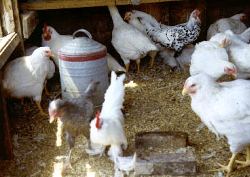 |
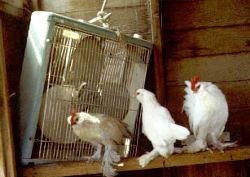 |
| Small Poultry Operation with Dirt Floor |
Make-shift Ventilation
in Poultry House |
| (Source: J. Sell, Iowa State University)
|
(Source: J. Sell, Iowa State University)
|
Prior to WWII, the majority of poultry were reared in backyard flocks
on dirt-floored pens, in small sheds with natural or make-shift ventilation.
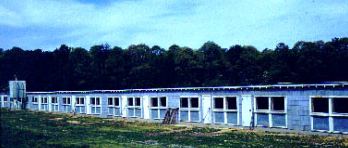
|
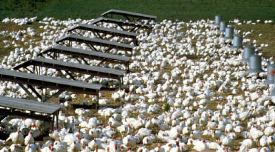
|
| An Early Year-round Production Building |
Poultry Grown in Large Outdoor Areas |
| (Source: J. Sell, Iowa State University)
|
(Source: J. Sell, Iowa State University)
|
Between 1940 and 1960, advancements in nutrition and genetics allowed
the broiler market to shift from being able to produce a 3-3.5 pound bird
at 16 weeks to one that only took 8 weeks. Due to advances in production
efficiency and refrigerated trucking, markets expanded to a much larger
geography while the price of poultry per pound dropped dramatically from
approximately 65 cents in 1940 to 29 cents in 1960. Due largely to changes
in price versus other meat options, demand for broilers increased dramatically.
Production systems during this time also underwent dramatic changes from
the seasonal, small backyard sheds to large year-round naturally ventilated
buildings and during some seasons, large outdoor pens.
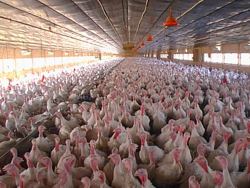 |
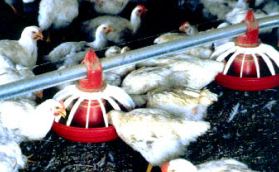 |
| Modern Enclosed Poultry Building |
On-demand Feeder Line |
| (Source: Purdue University) |
(Source: Purdue University) |
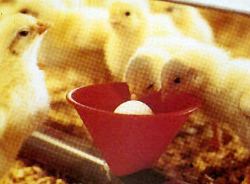 |
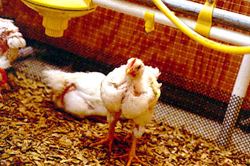 |
| On-demand Cup Waterer |
Nipple Waterer |
| (Source: Purdue University)
|
(Source: Purdue University)
|
Today, turkey and broiler flocks are reared in enclosed buildings with
updated equipment. For instance, birds are now reared in confinement with
on-demand feeder lines, on-demand cup or nipple waterers, or on-demand
bell-type waterers. These developments overcame most problems with weather,
predators, potential pollution from lot runoff, and allowed the use of
more intensive production schedules. Today, almost all turkeys and broilers
are reared on litter floors.
Ducks, turkeys, and occasionally broilers are reared in multi-stage facilities
with facilities for brooding
birds, and in larger facilities (either a separate room or separate building)
that they will be moved into at an older age.
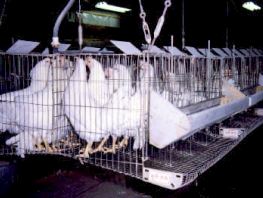 |
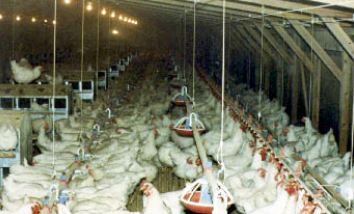
|
| Wire Cages |
Slotted Floor Facilities |
| (Source: Purdue University)
|
(Source: Purdue University)
|
Young pullets, laying hens, and broiler breeders are reared in either
wire-cages or slotted-floor systems. If a slotted flooring system is used,
there may or may not be a central area containing litter. Duck facilities
encompass a number of different production types and may or may not have
multistage facilities. Systems in use include all-litter houses, raised-wire
flooring over a shallow pit (which would be located below a nipple water
line) and houses with raised-wire floors.
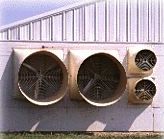
|
Mechanically
Ventilated Building |
| (Source: Purdue University)
|
Layers in commercial facilities produce a great deal of body heat. Ventilation
to keep the hens cool is usually more of a concern than providing heat in
winter. Non-brooding birds (3-4 weeks and older) grow best at around 70-75
degrees. In winter, they are protected from winter winds in an insulated
building. Enough ventilation must be provided to remove moisture produced
by the animals and to provide fresh air. In summer, large sidewall vents
are opened or large ventilation fans are operated to keep the animals comfortable.
This is referred to as either naturally ventilated (air change due to the
wind) or mechanically ventilated (where air is drawn into the buildings
through vents due to a negative pressure created with wall fans that exhaust
inside air to the outdoors. Further information on poultry
ventilation. 
Disadvantages associated with large enclosed, production facilities
are that different ages of birds with different degrees of disease resistance
are housed in close proximity which can facilitate disease spread if adequate
cleaning and disinfecting are not feasible in some situations, and higher
levels of medication may be required to control disease. The primary rule
of thumb for workers on a farm with multiple ages of birds is to always
travel from the youngest birds on the farm to the oldest, and not vice-versa.
Biosecurity plans between
farms, and between multiple production buildings on the same farm can
help reduce the incidence and spread of disease from one flock to the
next.
 Back
to Poultry Menu Back
to Poultry Menu
|

